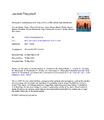Por favor, use este identificador para citar o enlazar este ítem:
http://hdl.handle.net/20.500.11765/11922
Atmospheric formaldehyde at El Teide and Pic du Midi remote high-altitude sites
| Título : | Atmospheric formaldehyde at El Teide and Pic du Midi remote high-altitude sites |
| Autor : | Prados-Román, Cristina; Fernández, Miguel; Gómez Martín, Laura; Cuevas Agulló, Emilio



 ; Gil-Ojeda, Manuel; Marusczak, Nicolas; Puentedura, Olga; Sonke, Jeroen E.; Saiz-Lopez, Alfonso
; Gil-Ojeda, Manuel; Marusczak, Nicolas; Puentedura, Olga; Sonke, Jeroen E.; Saiz-Lopez, Alfonso |
| Palabras clave : | Formaldehyde; Ground-based observations; Remote sensing; Free troposphere; Volatile organic compounds |
| Fecha de publicación : | 2020 |
| Editor: | Elsevier |
| Citación : | Atmospheric Environment. 2020, 234, 117618 |
| Versión del editor: | https://dx.doi.org/10.1016/j.atmosenv.2020.117618 |
| Resumen : | Formaldehyde (CH2O) is a tracer of the photochemical activity of the atmosphere. Linked to air quality, CH2O is an ozone (O3) precursor and serves as a proxy for natural and anthropogenic reactive organic emissions. As a product of the photooxidation of methane (CH4) and other hydrocarbons (e.g., isoprene), CH2O represents an important source of radicals in the remote free troposphere. This work aims at improving the characterization of this part of the troposphere where data are scarce. In particular, this study assesses the presence of CH2O at two high-altitude remote sites: El Teide (TEI, 3570 m a.s.l., Tenerife, Canary Islands, Spain) and Pic du Midi (PDM, 2877 m a.s.l., French Pyrenees). Through ground-based remote sensing measurements performed during two field campaigns in July (TEI) and September (PDM) 2013, this study presents the vertical distribution of CH2O at both locations. Results at PDM show that CH2O mixing ratios follow a decreasing vertical profile with a mean maximum of 0.5 ± 0.2 nmol mol−1 (i.e., ppbv) at the instruments' altitude. At TEI, observations indicate an uplifted layer of CH2O with a mean maximum of 1.3 ± 0.3 nmol mol−1 at 3.8 km a.s.l. (i.e., 300 m above the instrument's altitude). At both remote sites, the observed CH2O levels are higher than expected for background methane oxidation (a threefold increase in the case of TEI). Air mass back trajectory analysis links CH2O observations with abundant natural (e.g. forests) and/or anthropogenic isoprene emissions from the region nearby PDM, while the high CH2O levels detected at TEI indicate in-plume formation of CH2O resulting from its precursors emitted from west-African and Canadian fires. Finally, as a key trace gas for O3 and HOx chemistries, we estimate the upper limit of bromine monoxide (BrO) in the free troposphere at TEI and PDM to be 0.8 and 1.5 pmol mol−1 (i.e., pptv) respectively. |
| Patrocinador: | The TEI campaign was funded through the AMISOC project (Atmospheric MInor Species relevant to the Ozone Chemistry, Spanish National RCD Funding Agency, CGL2011-24891). The PDM campaign was funded by the European Research Council Executive Agency under the European Union´s Horizon 2020 Research and innovation program (ERC-2010-STG 258537) to JES. |
| URI : | http://hdl.handle.net/20.500.11765/11922 |
| ISSN : | 1352-2310 |
| Colecciones: | Artículos científicos 2019-2022 |
Ficheros en este ítem:
| Fichero | Descripción | Tamaño | Formato | ||
|---|---|---|---|---|---|
| 1-s2.0-S1352231020303... | 8,52 MB | Adobe PDF |  Visualizar/Abrir | ||
| PradosRoman et al_202... | 1,42 MB | Adobe PDF |  Visualizar/Abrir |
Los ítems de Arcimis están protegidos por una Licencia Creative Commons, salvo que se indique lo contrario.





